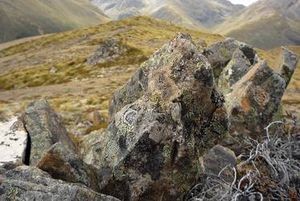 Lichens thrive in environments where other plants struggle, such as bare rock. Photo: Jesse BythellLichens are a symbiosis (two or more organisms living together more successfully than they could on their own). The basic components of lichens are a fungus called the ‘mycobiont’ and one or more algae and/or a cyanobacteria called the ‘photobiont’.
Lichens thrive in environments where other plants struggle, such as bare rock. Photo: Jesse BythellLichens are a symbiosis (two or more organisms living together more successfully than they could on their own). The basic components of lichens are a fungus called the ‘mycobiont’ and one or more algae and/or a cyanobacteria called the ‘photobiont’.
The following links and references will be useful to anyone interested in lichens. Australian references are provided since New Zealand shares many lichen species with Australia:
New Zealand
- Lichens of New Zealand: An Introductory Illustrated Guide (pdf 104MB)
- A useful field guide which illustrates and explains the diversity and morphology of our lichens written by lichenologist Dr Allison Knight. This guide has been published by the Botanical Society of Otago and is freely available in electronic form on the NZPCN website. Professionally printed copies can be purchased for $20 from the Botanical Society of Otago: Treasurer, BSO, PO Box 6214, Dunedin North 9059. [Enable JavaScript to view protected content]
- New Zealand’s Foliose Lichens: An Illustrated Key by Nancy and Bill Malcolm and Allison Knight. Micro Optics Press. (pdf 20.5MB). Excellent colour photos of all bar one of the NZ foliose genera, with an updated illustrated glossary of technical terms. This helpful booklet has been made freely available in electronic form by the authors and complements the other lichen guide above with diagrams, many colour photos and interesting information about NZ lichens.
- Flora of New Zealand: Lichens, Galloway, DJ (1985), Govt. Printer, Wellington.
- Flora of New Zealand: Lichens, (2nd, revised. edition), Galloway, DJ (2007) Manaaki Whenua Press, Lincoln. Full descriptions of all NZ lichens.
- New Zealand lichens, Checklist, Key and Glossary, Malcolm, WM & Galloway, DJ (1997) Museum of New Zealand, Te Papa Tongarewa, Wellington. With many detailed micro-photos of NZ lichens and an excellent illustrated glossary.
Australasian
- Australian Lichen Checklist - Contains 1400 illustrations, 3 Keys and links to scientific papers and journals.
- Australian Lichen Website - Good background information about lichens, with useful lists of lichen books and links.
- Details of Flora of Australia: Lichens (5 Vols.) and other Australian lichen books.
- Australasian Lichenology – publishes new discoveries in Australia and NZ.
- Lichens of rainforest in Tasmania and south-eastern Australia, Kantvilas, G; Jarman, SJ & Fuhrer, BA (1999) ABRS, Canberra. Beautiful colour photos of 127 of the lager macro-lichen species, with keys. Many also occur in our New Zealand forests.
International
Microscopic spores of lichens catch the wind and are often widely distributed around the world. These 3 websites contain a multitude of magnificent, often enlargeable colour images of lichens.
- North American Lichens – superb photos, many from the brilliant book with Irwin Brodo.
- British Lichens – with a pictorial key arranged by growth form and colour.
- Irish lichens - searchable alphabetically, by growth form and by habitat.
- Lichens: An illustrated guide to the British and Irish Species. Dobson, FS (2011) Richmond Publishing Co., England. Photos, brief descriptions and keys to over 1000 species.
For more information about lichens see:
